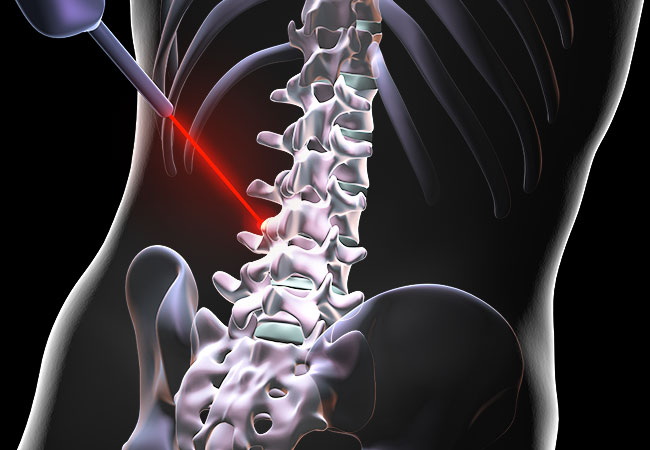Lasers work only for specific conditions
Cleveland Clinic, Health Essentials
Does the idea of stepping out of a surgery center pain-free, with only a small bandage on your back, sound appealing? It’s this image of a quick, easy cure that makes the idea of laser spine surgery so enticing to people with chronic back pain.
But if you are considering back surgery, you should know that while minimally invasive surgery using a laser is effective for some conditions, it isn’t a miracle cure, and it isn’t for everyone.
Michael Steinmetz, MD, Co-Director of Cleveland Clinic’s Center for Spine Health, offers insight on several questions about this treatment.
How does laser surgery compare with other methods?
Laser spine surgery may seem like a newer technique, but it actually has been around for decades. And, interestingly, it may not always mean that the surgeon will use a laser, Dr. Steinmetz says.
In the traditional approach to spinal surgery, the surgeon’s incision goes through the skin to the muscle. To get to the tissue or other problem area, the surgeon dissects the muscles away from the spine. This can damage the surrounding soft tissue, causing pain, blood loss and longer hospital stay for recovery.
An alternative to traditional “open” spine surgery is a minimally invasive procedure. Here, the surgeon makes a smaller incision and uses a tool to tunnel to the site of the pain. Because the muscles aren’t pulled away, damage to the surrounding area is minimal and the recovery time is often shorter.
More recently, this procedure has typically been called laser surgery. But Dr. Steinmetz says that what you are probably getting is minimally invasive surgery. Your surgeon may or may not use a laser (as opposed to a scalpel or other microsurgical instruments) for this technique.
When should a laser be used?
Dr. Steinmetz and his colleagues do use lasers to treat patients, but only for certain conditions. He says he rarely uses a laser for people with degenerative spine disease, for instance. However, he does use them for:
- Removing tumors from the spinal cord
- Removing bone or soft tissue around a nerve
- Shrinking disc material around a nerve
“In a standard practice, only about 30 percent of surgeries are appropriate for minimally invasive procedures, and that may not always involve using a laser,” he says.
What are the potential complications?
Inadequate operation: Perhaps the biggest problem with laser surgery is the risk of having an inadequate operation, which sometimes means you’ll need additional surgery, he says.
If you have leg pain caused by a spinal deformity, minimally invasive or laser surgery may improve the leg pain briefly, but may not fully treat the root cause.
“You may have pain from the back instability,” he says. “If all one uses is a laser, the bigger problem is missed.”
Nerve damage: Using a laser during surgery can sometimes limit nerve damage. But in the hands of an inexperienced surgeon, a laser can actually increase the chances of tissue or nerve damage, Dr. Steinmetz says.
How do you know which procedure is right for you?
Dr. Steinmetz recommends choosing a physician who is proficient in both traditional and minimally invasive approaches. Also, always get a second opinion before having back surgery.
To ensure that you are getting the best treatment for your condition, do your homework and prepare questions for your surgeon. Questions you should ask include:
- What does the operation entail?
- Will a laser likely be used?
- Will fusion be involved?
- Would a minimally invasive or traditional approach be better, and why?
- What alternative options are available?
- What will the surgery treat (back or leg pain, or both)?
- What are potential complications and complication rates?
- How experienced is the surgeon? Has the surgeon been trained formally (i.e. fellowship) in spine surgery and/or minimally invasive surgery?
- Does the surgeon do both traditional “open” procedures and minimally invasive surgery? This is ideal.
The bottom line is that more complicated back problems often require traditional surgery for the best outcome.
“There is no magic bullet or miracle for spine disease,” says Dr. Steinmetz. He chooses the best approach for each patient based on their particular case.

